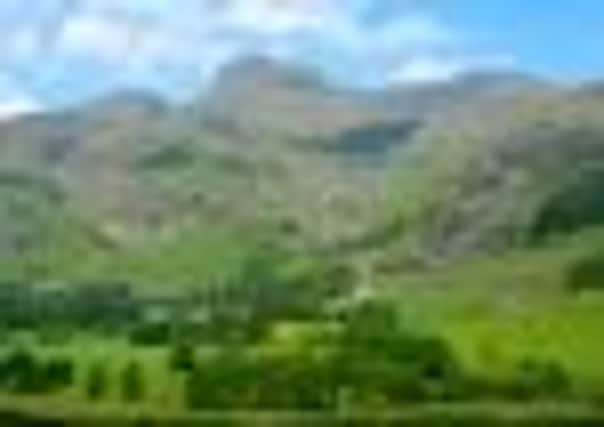Cumbria: High and Mighty


There’s a story about a group of British prisoners of war in Germany who discovered a mutual love of the Lakes, and whiled away their time behind the Stalag barbed wire by sketching from memory their favourite mountain views. The one everybody seemed to reproduce rock-perfect was the Langdale Pikes.
You might think that Wasdale Head, surrounded as it is by pyramid-shaped fells, would be easier to conjure up. Those simple 45 degree strokes are what small children would do if you asked them to draw mountains. But no, clearly and affectionately etched in the POWs’ minds was the outline of Harrison Stickle rearing above Great Langdale like the tower of a Gothic cathedral, and its long nave of vertical dark rock called Pavey Ark.
Advertisement
Hide AdAdvertisement
Hide AdYou can imagine how powerful that must have been as symbol of freedom. And for millions today it’s a tonic not available in tablet or bottle form, a view which never fails to thrill even when seen in the hazy distance.


Okay, Langdale doesn’t have Wasdale’s bragging rights of the highest mountain (Scafell Pike) and deepest lake (Wastwater), but as a base for a walking holiday it simply has no equal in this or any other National Park. And you get two valleys for the price of one if you count the parallel spur of Little Langdale.
The guidebook author Alfred Wainwright would have been able to draw the Langdale Pikes as well as any of those POWs, but in later life he grew to dislike Great Langdale because of its huge popularity. Time was, he wrote, a walker could wander here all day and hear only birds and the murmuring of streams. “We walked in fairyland. A solitary bus took us into the valley from Ambleside in the mornings and came back for us in the evenings. Those were halcyon days, gone, never to return.”
Of course, some would argue that Wainwright’s work attracts many of today’s visitors. Personally, I don’t mind Langdale’s popularity one bit because I don’t share dear old Wainwright’s misanthropic tendencies. I’ve enjoyed conversations with complete strangers on topics ranging from the weather forecast to the best sandwich takeaway and worst route back down to the valley floor, and then swapped stories of the day’s escapades with those new acquaintances when encountered later in the walkers’ bar at the Old Dungeon Ghyll Hotel.
Advertisement
Hide AdAdvertisement
Hide AdUnlike most other Lakes valleys, many low-level walking routes are available if rain is forecast or the usually alluring tops are veiled with cloud. You can follow the Cumbria Way down to Skelwith Bridge then take back-lanes and paths into Ambleside. You can walk over High Close from Elterwater to Grasmere and, if the weather starts to look promising, continue up to Easedale Tarn and traverse the gentle slopes of Blea Rigg to return by Langdale’s northern ridge.
You can walk over to Little Langdale, lingering among the beautiful oaks and birches above Chapel Stile and Elterwater, and cross the old Slaters’ Bridge to follow the small valley up to picturesque Blea Tarn and drop back down onto the table-flat sheep pastures of Great Langdale. Or head further south through the woods of Hodge Close, which hide the deepest quarry hole in England, and go over Holme Fell – a delightful little summit that punches well above its height – to visit the charming, chocolate-box lake of Tarn Hows.
But it is Langdale’s high places that many come to enjoy, and the group of fells known as the Langdale Pikes – Pavey Ark, Harrison Stickle, Loft Crag and Pike o’ Stickle – are among the most climbed tops in the Lakes. Like those POWs, I’ve come to know every bit of their craggy eminence. I’ve climbed them through thunder and lightning, in blizzards and in heatwaves, and almost came to grief one very icy day on the exhilarating rock scramble known as Jack’s Rake which forms an oblique scar across the great precipice of Pavey Ark.
Anyone who wonders how people can possibly get enjoyment from such discomfitures and danger should, as their first fellwalking experience, take the infallible path rising from behind Stickle Barn Tavern and follow the rushing waters of Stickle Ghyll to the dark and almost sinister pool of Stickle Tarn. Surrounded on two sides by fearsome rockfaces and scree chutes, it is one of the most dramatic places in the Lakes and for many this modest climb is the start of a lifetime’s love affair with the fells.
Advertisement
Hide AdAdvertisement
Hide AdI would have thought that GPS devices might have replaced Wainwright’s books on the fells, but they are still to be seen in many map cases.
Thirty years ago, when the Wainwright cult was at its height, I encountered some walkers in Great Langdale staking out a parked blue Ford Anglia, from which someone bearing a strong resemblance to the guidebook writer had been seen setting off into the fells. I don’t know what the car’s owner thought of his welcoming party when he returned, but I do know that Wainwright was always driven around by his wife in a green VW Beetle.
GETTING THERE...
* Roger Ratcliffe stayed at the Britannia Inn, Elterwater. Tel. 01539 437210 or visit www.britinn.net
* He has often used the large National Trust campsite at Great Langdale. Tel. 01539 432733.
Advertisement
Hide AdAdvertisement
Hide Ad* The Wainwright Pictorial Guides to the Lakeland Fells which cover the walks mentioned are: Book Three, The Central Fells; and Book Four, The Southern Fells. Published by Francis Lincoln, £12.99.
* The OS Explorer Maps (1:25000 scale) required are English Lakes South-western Area OL6 and South-eastern Area OL7.